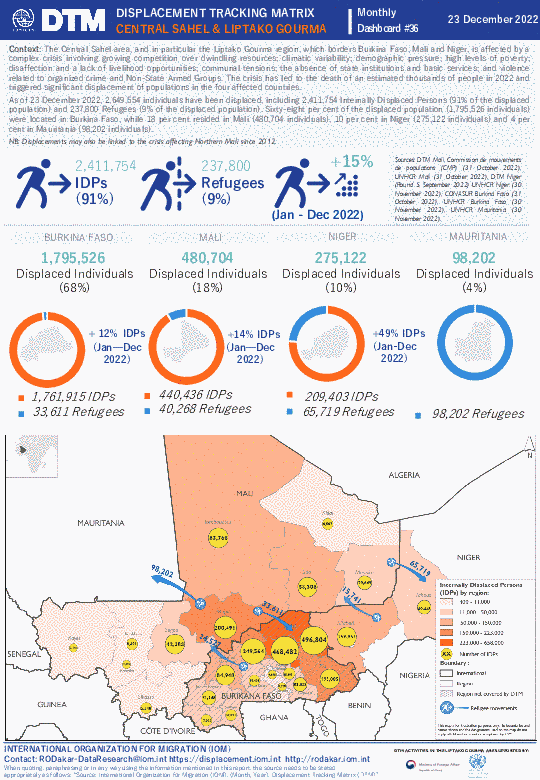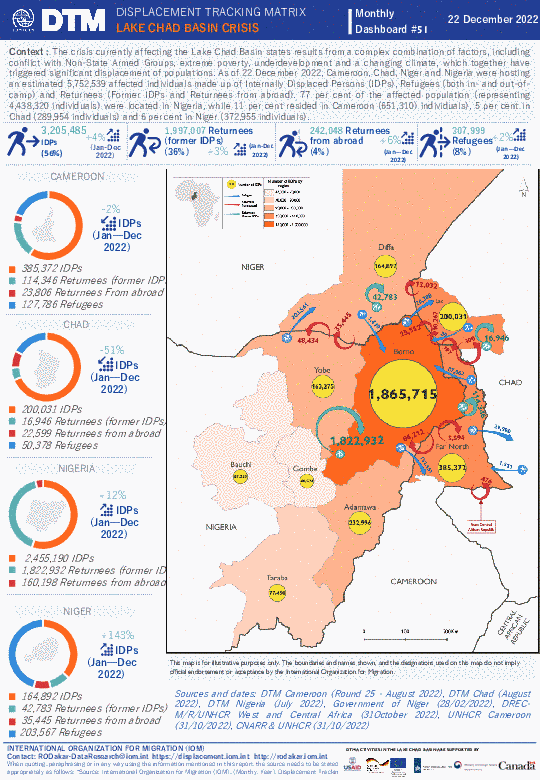-
Countries
-
Data and Analysis
-
Special Focus
-
Crisis Responses
Contact
DTM Sudan, DTMSudan@iom.int
Location
Sudan
Activity
- Mobility Tracking
- Baseline Assessment
Period Covered
Feb 15 2022 -Mar 16 2022
DTM estimates a total number of 1,181,419 permanent returnees from internal displacement (221,754 households) across 10 states in Sudan. Reporting on returns in a chronological manner, the data indicates that between 2003 and 2010, 152,928 returnees (13%) returned to their location of origin. The highest proportion of returns (340,946) occurred between 2011 to 2015 (29% of the total count) – reflective of a mass influx of individuals returning to their habitual residences at the end of the Darfur crisis. This was followed by 155,523 returnees (13%) in 2016, 165,965 returnees (14%) in 2017, and 120,116 returnees (11%) in 2018.
The lowest proportion of returnees returned in 2019 (67,745) and 2020 (66,157), representing 6% and 5% respectively. The steady decrease in returns over time suggests a correlation between the increased length of protracted displacement and the
diminishing likelihood of returns. Finally, in 2021 field teams identified 112,029 permanent returnees from internal displacement (9%).
Population Groups
Survey Methodology
Unit of Analysis Or Observation
Type of Survey or Assessment
Keywords
Geographical Scope
Administrative boundaries with available data
The current dataset covers the following administrative boundaries
Contact
DTM Sudan, DTMSudan@iom.int
Location
Sudan
Activity
- Mobility Tracking
- Baseline Assessment
Period Covered
Feb 15 2022 -Mar 16 2022
DTM identified a total accumulative number of 3,779,487 IDP individuals (748,100 households) in 17 states across Sudan. The greatest proportion of displacement in the country is protracted (ongoing for more than five years, see Diagram 4). An estimated 2,238,797 current IDPs (59%) were initially displaced between 2003 and 2010 at the height of the Darfur crisis. In comparison, 1,034,351 IDPs (27%) captured were initially displaced between 2011 and 2017, in addition to 69,646 (2%) newly displaced in 2018; 85,171 IDPs (2%) in 2019; 66,356 IDPs (2%) in 2020; 284,579 (8%) in 2021 and additional 587 IDP individuals were captured in 2022.
Population Groups
Survey Methodology
Unit of Analysis Or Observation
Type of Survey or Assessment
Keywords
Geographical Scope
Administrative boundaries with available data
The current dataset covers the following administrative boundaries

Contact
Regional Office Dakar, RODakarepcteam@iom.int
Language
French
Location
Senegal
Period Covered
Oct 01 2022
Oct 31 2022
Activity
- Flow Monitoring Survey
- Flow Monitoring
Durant le mois d’octobre 2022, au total 6336 migrants ont été observés au niveau du point de suivi des flux transfrontalier de Rosso Sénégal (5628 individus entrants au Sénégal par les FMP, 276 individus sortants du Sénégal par le FMP de Rosso et 144 individus effectuant des mouvements internes passant par le FMP de Rosso). La moyenne journalière des flux est de 233 soit une hausse de 57 pour cent par rapport au mois de septembre 2022. Cette hausse s’explique d’une part par l'avènement de plusieurs évènements religieux au Sénégal (Gamous) et par des mouvements économiques et des mouvements locaux de courte durée d'autre part.

Contact
Regional Office Dakar, RODakar-DataResearch@iom.int
Language
English
Location
The Gambia
Period Covered
Nov 01 2022
Nov 30 2022
Activity
- Flow Monitoring Survey
- Flow Monitoring
In The Gambia, DTM conducts Flow Monitoring activities at several important transit locations in:
1) Barra (FMPs are located at the ferry terminal and the main garage);
2) Farafenni (FMPs are located at Farafenni main garage, Farafenni Ballan-Ghar garage, Farafenni McCarthy and Sanjally garage, Farafenni turntable garage and the truck garage);
3) Basse (FMPs are situated at the main garage and the bus station in Basse Santa-Su) and
4) Brikama (FMPs are located at the main garage and the bus station).
These activities enable DTM to monitor the movements of passengers within, out of and towards The Gambia as well as the movements of those passengers transiting The Gambia. This report presents the key results of the Flow Monitoring Survey conducted from the 1st to the 30th of November 2022, excluding weekends and national holidays, with data collected for 22 days. The report presents data collected on flows, routes, departures, destinations and demographic profiles of travellers observed at the FMPs
La région du Sahel central, et plus particulièrement la zone du Liptako Gourma, qui enjambe le Burkina Faso, le Mali et le Niger, est témoin d’une crise complexe qui comprend comme enjeux une compétition grandissante pour le contrôle de ressources; des bouleversements climatiques; une croissance démographique galopante; des niveaux élevés de pauvreté; l’absence d’opportunités économiques et un sentiment de désillusions quant au futur; des tensions communautaires; l’absence de présence étatique et le manque de services sociaux de base; et des violences provoquées par des réseaux de crime organisé et des groupes armés non étatiques. La crise a engendré, en 2022, la mort de milliers de personnes et conduit à des déplacements de populations significatifs dans les quatre pays touchés par la crise.
Au 23 novembre 2022, 2 649 554 individus étaient déplacés par la crise, y compris 2 411 754 Personnes déplacées internes (91% de la population affectée) et 237 800 réfugiés (9%). Soixante-huit pour cent de la population déplacée (1 795 526 personnes) se trouvait au Burkina Faso, 18 pour cent au Mali (480 704), 10 pour cent au Niger (275 122) et 4 pour cent en Mauritanie (98 202).
The Central Sahel area, and in particular the Liptako Gourma region, which borders Burkina Faso, Mali and Niger, is affected by a complex crisis involving growing competition over dwindling resources; climatic variability; demographic pressure; high levels of poverty; disaffection and a lack of livelihood opportunities; communal tensions; the absence of state institutions and basic services; and violence related to organized crime and Non-State Armed Groups. The crisis has led to the death of an estimated thousands of people in 2022 and triggered significant displacement of populations in the four affected countries.
As of 23 December 2022, 2,649,554 individuals have been displaced, including 2,411,754 Internally Displaced Persons (91% of the displaced population) and 237,800 Refugees (9% of the displaced population). Sixty-eight per cent of the displaced population (1,795,526 individuals) were located in Burkina Faso, while 18 per cent resided in Mali (480,704 individuals), 10 per cent in Niger (275,122 individuals) and 4 per cent in Mauritania (98,202 individuals).
La crise dans le Bassin du lac Tchad est le résultat d’une combinaison complexe d’une multitude de facteurs, y compris un conflit armé impliquant des groupes armés non étatiques, des niveaux extrêmes de pauvreté, un sous-développement persistant, et des bouleversements climatiques, qui ont conduit à des déplacements de populations importants. Au 22 décembre 2022, le Cameroun, le Tchad, le Nigeria et le Niger accueillaient 5 752 539 individus affectés par la crise, dont des Personnes déplacées internes (PDI), des réfugiés et des retournés (anciennes PDI et retournés de l’étranger). 77 pour cent d’entre eux (soit 4 438 320 personnes) se trouvaient au Nigéria, 11 pour cent au Cameroun (651 310 personnes), 5 pour cent au Tchad (289 954 personnes) et 6 pour cent au Niger (372 955 personnes).
The crisis currently affecting the Lake Chad Basin states results from a complex combination of factors, including conflict with Non-State Armed Groups, extreme poverty, underdevelopment and a changing climate, which together have triggered significant displacement of populations. As of 22 December 2022, Cameroon, Chad, Niger and Nigeria were hosting an estimated 5,752,539 affected individuals made up of Internally Displaced Persons (IDPs), Refugees (both in- and out-of-camp) and Returnees (Former IDPs and Returnees from abroad). 77 per cent of the affected population (representing 4,438,320 individuals) were located in Nigeria, while 11 per cent resided in Cameroon (651,310) individuals), 5 per cent in Chad (289,954 individuals) and 6 per cent in Niger (372,955 individuals).

Contact
DTM Nigeria, iomnigeriadtm@iom.int
Language
English
Location
Nigeria
Period Covered
Nov 26 2022
Dec 04 2022
Activity
- Event Tracking
The rainy season in Nigeria typically occurs annually with the greatest concentration of precipitation between the months of June and September. Many states in Nigeria have been affected by unprecedented heavy rainfalls and floods have devastated various communities. Infrastructure, crops, and shelters have been damaged which led to decimated livelihoods and the displacement of numerous households.
Between 26 November and 4 December 2022, DTM, in collaboration with the Nigerian Red Cross Society (NCRS) identified 28 locations in Rivers State that were affected by the floods and/or received IDPs that are currently displaced as a result of the floods. In the nine (9) Local Government Areas (LGAs) of Rivers State that were assessed, DTM identified 337,393 individuals in 60,963 households that were affected by the floods. These affected individuals included IDPs (123,233 individuals) who are currently displaced by the floods, residents (132,324 individuals) who were affected by the floods but remained in their respective communities and returnees (81,836 individuals) who were displaced by the floods but have since returned to their communities.
Les zones géopolitiques du nord-ouest et du nord-centre du Nigéria et la région de Maradi au Niger sont touchées par une crise multidimensionnelle - enracinée dans des clivages ethno-sociaux historiques - ravivée en 2013 suite à la dégradation des conditions politiques, socio-économiques et environnementales dans le nord du Nigéria. Cette crise renferme des conflits anciens entre groupes ethniques et linguistiques, des tensions entre pasteurs nomades (transhumance) et agriculteurs sédentaires, des attaques de groupes criminels contre les populations locales et le banditisme/hirabah (enlèvement et criminalité le long des grands axes routiers). Les tensions et conflits autour des ressources et des terres, exacerbées par le changement climatique, ont dégénéré en conflits communautaires ayant entraîne le déplacement d’un grand nombre de personnes. Ces dernières années, la crise s'est étendue à la région de Maradi au Niger, entraînant l’arrivée de réfugiés nigérians et des déplacements internes dans cette région.
La crise a entraîné la mort d'environ 2 300 personnes en 2022 (à la date du 30 juin) et déclenché d'importants déplacements de populations dans les deux pays touchés. Au 23 décembre 2022, 1 222 977 personnes étaient déplacées, dont 1 110 369 personnes déplacées à l'intérieur de leur propre pays (91% de la population déplacée), 15 177 personnes retournées (anciennes PDI) (1%) et 97 431 réfugiés (8% de la population déplacée). Quatre-vingt-neuf pour cent de la population déplacée (1 087 875 personnes) se trouvaient au Nigéria, tandis que 11 % résidaient au Niger (135 102 personnes).




